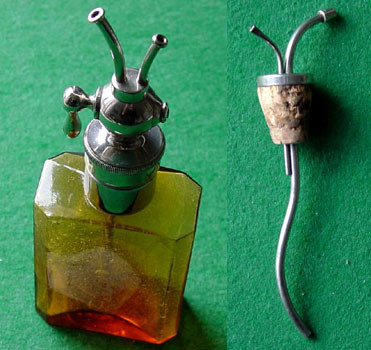|
The first inhalation anesthetic in history was hashish. In fact, the ancient Scythians burned hemp seed in their tents to become intoxicated - unfortunately, the Scythians failed to introduce the hemp vapors into the surgical practice. Only the Romans discovered the analgesic effect: Pliny the Elder writes that hemp alleviates pain, and Pedanios Dioscurides reports on the effectiveness of the juice of hemp seeds against earache. From the Middle Ages to modern times, hemp has been used to reduce the amount of labor cramps and postnatal pain symptoms.
On the left in the picture a bottle with a lock, on the right in the picture a drip stopper without a stopcock - this type of bottle was closed by attaching a small cap to each opening, whereby the two copings were connected by means of chains.
Aether for the dying
Aether has been known since the 13th century, but found no use in medicine. "Sur la commode, autel improvisé, j'aperçus un crucifix, un rameau de buis, enfin, tous les apprêts d'un sacrue redoutable, en même temps, je sentis une odeur d'ether, ce parfum des mourans, et mon coeur se glaça, car je crus respirer une exhalaison de la tombe "(Charles de Bernard, La peine du talion, in Courrier du Grand-Duché de Luxembourg of 7.10.1846). Why is death associated with aether in this text? It can be read that ether was injected at the beginning of the 20th century to bring dying people back to life:
"Au début du xxe siècle, et surtout dans l'entre deux guerres, avec les progrès technique, certain clercs n'hésitent pas à recommander l'emploi de cordiaux (injections intraveineuses ou même intracardiaques d'éther, de caféine, d'huile camphrée d'adrénaline) ou la mise en œuvre du massage cardiaque pour ranimer le cœur défaillant des moribonds "(Maurice D'HALLUIN, Résurrection du cœur, la vie du cœur isolé, le massage du cœur, Paris, Vigot, 1904).
But that was in 1904, not 1846. We believe that Bernard allowed poetic freedom and imagined that he had "smelled" the "ethereal body" that leaves the body with death. In fact, Aether in low concentration stimulates the spinal cord with the appearance of increased reflexes. But it never succeeds in reviving vital reflexes.
As early as 1936, ether-anesthesia was recommended in the specialist press as the most harmless method for the general practitioner (Prof. G. Lotheissen, Anesthetic Methods in the Hands of the Practical Physician, in: WMW No. 16 of 18 April 1936).
|




